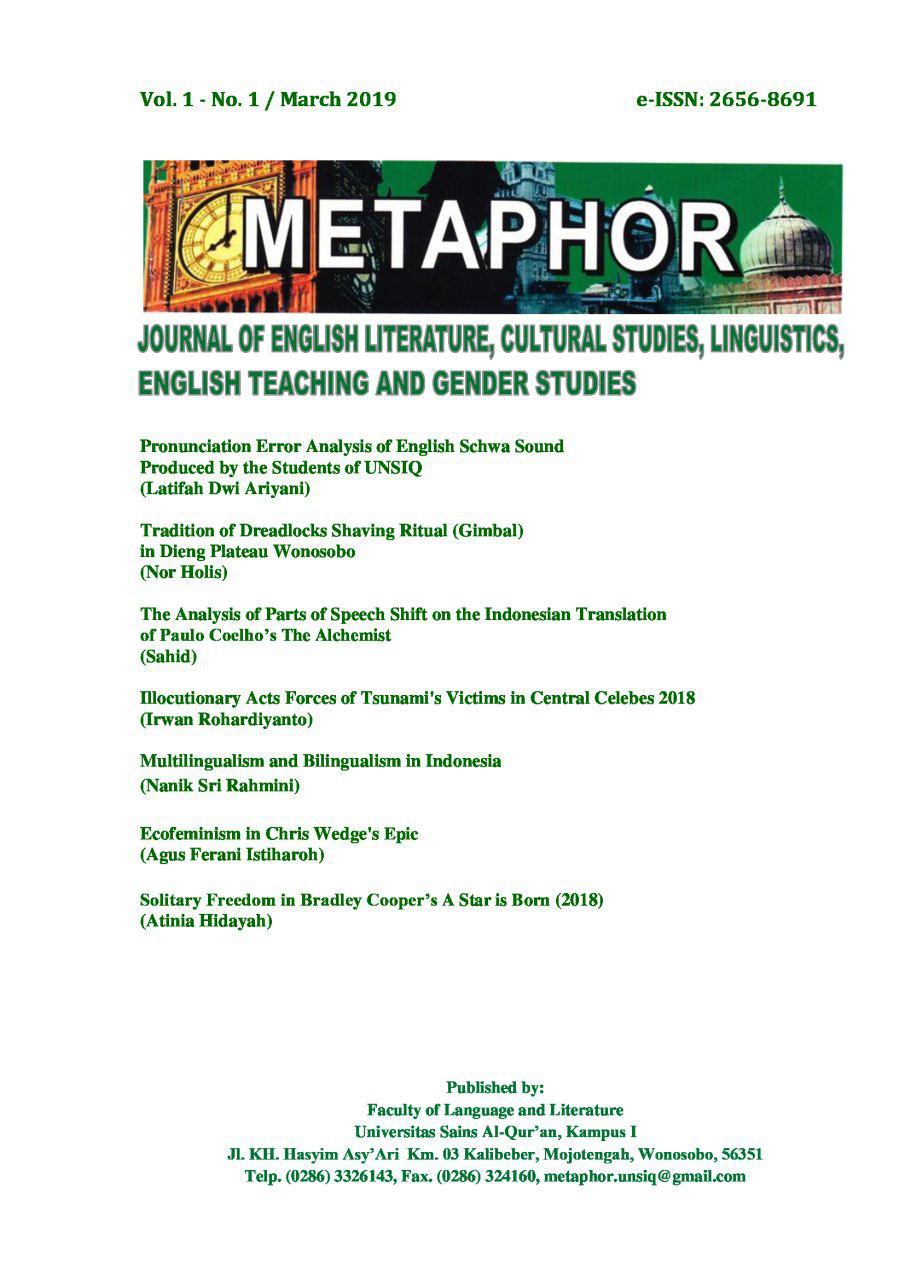Multilingualism and Bilingualism in Javanese Society
Abstract
This study aims at analyzing the case study of multilingualism and bilingualism in three provinces in Java, among others are East Java, Yogyakarta, and Central Java. The people from the three provinces communicate with two or more than languages which causes double-overlapping diglossia phenomenon. The diglossia phenomenon happens in the use of language spoken by the majority and minority people lived in the provinces. This study is qualitative study. The data is collected through library research and the language observation in the field. The study shows that the language shift from Javanese to Bahasa Indonesia happens in the Javanese society. Kromo Inggil is rarely used by the society. They tend to shift the language by speaking Bahasa Indonesia for their daily conversation. However, the Javanese language is used in the way the family members communicate each other with their immediate family. Hence, Javanese language can be insured that it will be used by the next generations.
Downloads
References
Burns. D. 1968. Bilingual Education in the Andes of Peru. In J. A. Fishman, C. A. Ferguson, & J. D. Gupta. (Eds) Language Problems of Developing Nations. (403-413). John Wiley & Sons. Inc.
Chaer, A. & Agustina, L. 1995. Sosiolinguistik Perkenalan Awal. Jakarta: Rineka Cipta.
Edwards, J. 1994. Multilingualism. London, England: Routledge.
_______. 2010. Minority Languages and Group Identity: Cases and Categories. Amsterdam/Philadelpia: John Benjamins Publishing Company.
Ewing, M. 2005. Colloquial Indonesian. In A. Adelaar& N. P. Himmelmann. (eds) The Austronesian Languages of Asia and Madagascar.Routledge London.
______. 1984. The Sociolinguistics of Society. Oxford: Basil Blackwell.
Fasold, R. (1990). Sociolinguistics of Language. Oxford: Blackwell Publisher.
______. 2014. The Politics of Language. In R. W. Fasold & J. Connor-Linton. (Eds) An Introduction to Language and Linguistics. (pp. 383-412). Cambridge: Cambridge University Press.
Ferguson, C. A. 1959. Diglossia. Word, 15: 325–40. In Giglioli (1972) and Hymes (1964).
Fishman, J. A. 1964. Language Maintenance and Language Shift as a Field of Inquiry. Linguistics 9: 32-70.
______. 1972. The Sociology of Language. Rowley: Newbury House.
______. 1997. Reversing Language Shift. UK: Multilingual Matters Ltd.
Florey, M.J. 2001. ‘Threats to indigenous knowledge: a case study from eastern Indonesia’. In L. Maffi (ed.) on Biocultural Diversity: linking language, knowledge and the environment (pp. 325-342).Washington DC, USA: Smithsonian Institute Press.
Francis-Borgias A. 1993. Social Norms and Variation in Language Choice: The Case of English-speaking Students in Java. PhD Thesis State University of New York at Stony Brook.
García, O. 1985. Bilingualism in the United States: Present attitudes in the light of past policies. The English Language T Odd]. Oxford: Pergamon Institute of English, 147-158.
Giglioli, P. P. (ed.). 1972. Language and Social Context: Selected Readings.Harmondsworth, England: Penguin Books.
Hamida, L. 2011. Family Values in the Maintenance of Local/Home Language. Retrieved from: https://core.ac.uk/download/pdf/11735823.pdf
Hymes, D. H. (ed.). 1964. Language in Culture and Society: A Reader in Linguistics and Anthropology. New York: Harper & Row.
Kaplan, R.B.& Baldauf, Jr. R.B. 1997. Language Planning: From Practice to Theory Multilingual Matters UK.
Kurniasih, Y. 2006. Gender, Class and Language Preference: A case study inYogyakarta. In K. Allan (ed.), Selected papers from the 2005 Conference of the Australian Linguistic Society. http://www.als.asn.au.
Lado, R. 1964. Language Teaching: A Scientific Approach. New York: McGraw-Hill.
Lambert, W.E. 1975. Culture and Language as Factors in Learning and Education. In A. Wolfgang (Ed.) Education of Immigrant Students. Toronto: Ontario Institute for Studies in Education.
Mackey, W. F. 1967. Bilingualism as a World Problem. Montreal: Harvest House.
Macnamara, J. 1970. Bilingualism and Thought. In J. E. Alatis (Ed). Monograph Series on Languages and Linguistics. Georgetown University School of Languages and Linguistics.
Montgomery, M. 1995. An Introduction to Language and Society. London, England: Routledge.
Musgrave, S. 2011. Language Shift and Language Maintenance in Indonesia. http://users.monash.edu.au/~smusgrav/publications/LMLS_Indonesia_Musgrave.pdf. Retrieved: 13 February, 2016.
Romaine, S. 1995. Bilingualism. Oxford: Blackwell.
Subagio, A. 2013. Go…Go… Indonesia: 101 Alasan Aku Bangga Jadi Anak Indonesia. Retrieved from http://books.google.com.
Trudgill, P. 2000. Sociolinguistics: An Introduction to Language and Society. London, England: Penguin Books.
Wahyudin. 2012. Bilingualisme: Konsep dan Pengaruhnya Terhadap Individu.
http://staff.uny.ac.id/sites/default/files/penelitian/Ahmad%20Wahyudin,%20S.S.,M.Hum./Makalah%20PIBSI.pdfRetreived: 13 February 2016.
Wardhaugh, R. 2008. An Introduction to Sociolinguis-tics. Oxford: Basil Blackwell.
Wei. L. 2013. Conceptual and Methodological Issues in Bilingualism and Multilingualism Research. In T. K. Bhatia & W. C. Ritchie (Eds). The Handbook of Bilingualism and Multilingualism. (26-51). Blackwell Publishing Ltd.
Wolff, J.U. & Poedjosoedarmo S. 1982. Communicative Codes in Central Java. Cornell University Ithaca.
Wright, W. 2013. Bilingual Education. In T. K. Bhatia & W. C. Ritchie (Eds). The Handbook of Bilingualism and Multilingualism. (598-623). Blackwell Publishing Ltd.



